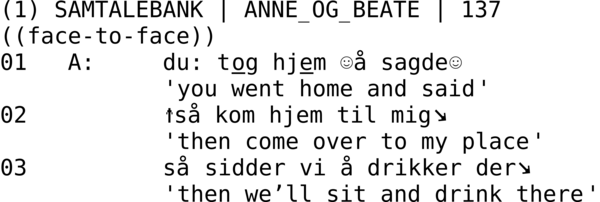Parody in reported speech
It is a well-known phenomenon that people sometimes quote others’ speech or thoughts in conversation. An example of this can be seen below:

Here, A’s utterances in lines 2 and 3 refer to something the other person in the conversation has said at a previous occasion. This phenomenon is well-described within linguistics and is typically referred to as, among other terms, reported speech.
In our investigations of interaction, we have found that people sometimes do a parody of the person they are reporting. It can be described as the speaker putting on an act or linguistically dressing up and thereby demonstrating a stance towards the utterance. For example, through the use of parody a speaker could express a humorous or ridiculing stance to something a person has said or done. This is demonstrated in the example below:
![(2) AULING | MANDARINER | 164 ((face-to-face)) 01 B: og så ss sidder alberte med sån et 'and then Alberte is sitting with like a' 02 B: øh lammetæppe over 'uh lamb wool blanket over' 03 B: sån pakket ind 'like wrapped up' 04 B: og så siger hun bare 'and then she just says' 05 B: ▔lady gaga↗▔ 06 B: ▔jeg er lady gaga↗▔ 'I’m Lady Gaga' 07 B: (h)hhh 08 A: [nå::h↘ ] 'aww' 09 B: [(h)hun bare så]n me:ga sød 'she is just like super cute'](/fileadmin/_processed_/9/b/csm_parody_in_reported_speech_2_899fcc2f3e.png)
In lines 5-6, B is reporting her daughter’s speech. This is done with a markedly higher pitch than her normal register. It seems she is imitating the daughter’s voice. At the same time, with the use of gesture she mimics being wrapped in a lamb wool blanket. In this way, she is expressing how the daughter did something cute or adorable at the time. A comments on this in line 8: nå::h↘.
We consider this a resource interesting to investigate as it can serve a specific function in interaction. Namely, parody in reported speech can be used to end a story. We see part of this in the example above where B’s parody of the daughter is followed by an assessment by A in line 8. Typically, story-telling in interaction is followed by assessments as we see in lines 8 and 9 above.
This is shown even more clearly in the next example below. A orients towards B’s story as having reached its end after an instance of parody in reported speech:
![(3) SAMTALEBANK | ANNE_OG_BEATE | 174 ((ansigt-til-ansigt)) 01 B: å så ringer du 'and then you call' 02 B: å jeg kunne over ↑ho:vedet ikke høre hva du siger 'and I could not hear what you were saying at all' 03 B: ∙hhhh 04 B: å så siger du vi er på LUx å så siger du 'and then you say we’re at Lux and then you say' 05 B: ▔JA:∙h▔ 'yes' 06 B: ▔øh prøv li:ge å: komme å:: å hent mig↓▔ 'uh come and pick me up' 07 A: na:j [☺det var ikke der☺ ] 'no that was not what' 08 B: [og jeg var li:ge kommet ind ]= 'and I had just gotten in' 09 A: =☺jeg sagde☺ 'I said'](/fileadmin/_processed_/b/2/csm_parody_in_reported_speech_3_123cb19526.png)
Here, we see how B parodies A as part of her story in lines 5-6. B is speaking in a pitch level significantly higher than her normal register. Line 7 is interesting, as A comments on B’s story. She hereby orients towards the story as having ended in line 6. Even though B continues her story in line 8, we see that A understands the use of parody in reported speech in lines 5-6 as the end of the story.
The three examples demonstrate how parody in reported speech can be a resource for ending a story. The same resource can quite possibly be employed in other situations apart from story-telling. At this point, we have not investigated this particular phenomenon further. However, we find it reasonable to assume that the function this resource serves in other contexts overlaps with the function it serves in story-telling. For example, parody could be seen as an invitation to laughter, and as a way of pointing out the climax of the story to the listener. The speaker can indicate what the point of the story is, and thus what is supposed to be assessed by the listener.
Sources and further reading
Jefferson (1978). A classic article about story-telling in interaction.
Mikkelsen & Kragelund (2015). About how parodied speech can be used to end stories in interaction.
Sacks (1974). An analysis of how a joke is told, and how the teller shows, that he has reached the punchline of the joke.
Steensig (2001) provides an an overview of research on prosody in interaction, among other things.
Related entries
The Building Blocks of Talk-in-interaction > Sounds > Prosody
The Building Blocks of Talk-in-interaction > Discursive units > Story telling
Social Actions > Initiation and completion of activities
Social Actions > Informing, reporting and telling actions > Story telling
Social Actions > Evaluating actions > Judgement
